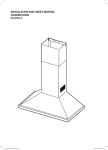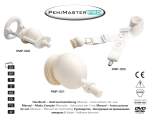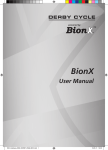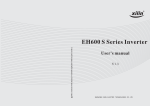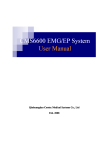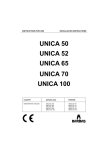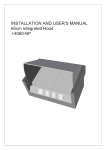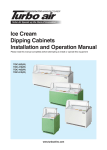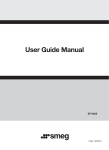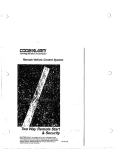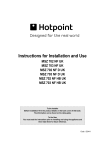Download INSTALLATION AND USER`S MANUAL COOKER HOOD
Transcript
INSTALLATION AND USER’S MANUAL COOKER HOOD F-2060 F-2060-GB-04.indd 1 5/31/2010 5:29:55 PM TABLE OF CONTENTS 1. 2. 3. 4. 5. 6. 7. 8. 9. 10. Introduction Safety precaution Intended use Parts supplied Installation Operation Maintenance Troubleshooting Technical data Environmental protection • 2 2 3 3 3 5 5 5 5 5 • • • 1. INTRODUCTION • Thank you for choosing this cooker hood. This installation and user’s manual is designed to provide you with all required instructions related to the installation, use and maintenance of the appliance. In order to operate the appliance correctly and safety, please read this installation and user’s manual carefully before installation and usage. Keep this installation and user’s manual for future use. Should this appliance be passed on to a third party, then this installation and user’s manual must be included. No liability will be accepted for damage resulting from improper use or non-compliance with these instructions. • • • • 2. SAFETY PRECAUTION • Important! Always switch off the electricity supply at the mains during installation and maintenance such as for light bulb replacement. General • The cooker hood is suitable for domestic use only. Gas safety Children • • • Please dispose of the packaging material carefully. Packaging material can be dangerous to children. Danger of suffocation! Children should be supervised to ensure that they do not play with the appliance. • • • • • Danger of fire! • Do not flambé under the cooker hood. • Do not leave frying pans unattended during use because overheated fats or oils might catch fire. • Never leave naked flames under the cooker hood. • Only fry underneath the cooker hood when you are in the kitchen. • Do not use the cooker hood without the grease filters, or if the filters are excessively greasy! The cooker hood must be installed in accordance with the installation instructions and all measurements must be followed. All installation work must be carried out by a competent person or qualified electrician. When installing the cooker hood, make sure that the following recommended distances between the top of cooker and the lowest part of the cooker hood are observed: Gas cookers: 70cm Electric cookers: 67cm Coal or oil cookers: 80cm Do not install above a cooker with a high level grill. Make sure the ducting has no bends sharper than 90 degrees as this will reduce the efficiency of the cooker hood. Pay attention to the sharp edges inside the cooker hood during installation. Caution! Accessible parts may become hot when used with cooking appliances. Exhaust operation Danger! • During exhaust operation, the cooker hood removes air from a room. If other fire sources that require the surrounding air for combustion are being operated in the same room, (e.g. gas, oil or coal heaters), the oxygen they require is taken away. Thus flames could be suffocated and gas could leak out or the fumes could be drawn back into the room. • In order to guarantee a safe operation, there should be nonclosable openings in doors, windows or in an air intake wall box to ensure a fresh supply of combustion air. This will prevent the combustion fumes from being drawn back into the room. Electrical safety • • Always put lids on pots and pans when cooking on a gas cooker. Operation Installation • Before connecting the appliance to the power supply, check that the power supply voltage and current rating corresponds with the power supply details shown on the appliance rating label. Never use a damaged appliance! Disconnect the appliance from the power source and contact your supplier if it is damaged. Danger of electric shock! Do not attempt to repair the appliance yourself. In case of malfunction, repairs are to be conducted by qualified personnel only. To avoid damaging the cord, do not squeeze, bend or chafe it on sharp edges. Keep it away from hot surfaces and open flames as well. Lay out the cord in such a way that no unintentional pulling or tripping over it is possible. Do not open the appliance casing under any circumstances. Do not insert any foreign objects into the inside of the casing. Never use accessories which are not recommended by the manufacturer. They could pose a safety risk to the user and might damage the appliance. Only use original parts and accessories. Keep the appliance away from any hot surfaces and open flames. Install the appliance on a level, stable, clean and dry surface. Protect the appliance against heat, dust, direct sunlight, moisture, dripping and splashing water. Do not place heavy objects on top of the appliance. Do not place objects with open flames, e.g. candles, on top of or beside the appliance. Do not place objects filled with water, e.g. vases on or near the appliance. This appliance is not intended for use by persons (including children) with reduced physical, sensory, or mental capabilities, or by those who lack experience and knowledge, unless they have been given supervision and instruction concerning the use of the appliance by a person responsible for their safety. Regularly check the power cord for damage. If the supply cord is damaged, it must be replaced by the manufacturer, its service agent or similarly qualified persons in order to avoid a hazard. The appliance must be installed in such a way, that the power supply is accessible at all times. 2 F-2060-GB-04.indd 2 5/31/2010 5:29:55 PM • • • • • 5. INSTALLATION When assessing the measures necessary, always take the entire ventilation system of the house into consideration. In case of doubt, ask your local chimney sweeper for help. Never secure the cooker hood to a ventilation duct, or a room or exhaust gas chimney! Do not let the air that is removed from the room be drawn into a duct where warm air is circulating. The extracted air should only be drawn outdoors through a separate ventilating duct that is only for the extractor hood. When in extraction mode, air in the room is being removed by the cooker hood. Please make sure that proper ventilation measures are being observed. The cooker hood removes odours from room but not steam. There shall be adequate ventilation of the room when the range hood is used at the same time as appliances burning gas or other fuels (not applicable to appliances that only discharge the air back into the room). The air must not be discharged into a flue that is used for exhausting fumes from appliances burning gas or other fuels (not applicable to appliances that only discharge the air back into the room). • Preparation • Cleaning • • • • • There is a fire risk if cleaning is not carried out in accordance with the instructions. Pay attention to the sharp edges inside the cooker hood, especially during cleaning. Always disconnect the power supply prior to cleaning the cooker hood or the filter. If the switched fused connection unit is difficult to reach, shut off the power supply by using the corresponding circuit breaker at the distribution board. Keep the cooker hood clean. Fat deposits could light on fire when exposed to high temperatures. • • 3. INTENDED USE • • • Your cooker hood can be operated in recirculated-air operation or in exhaust operation. Recirculated-air: Kitchen fumes are removed and after purification are fed back into the room through the upper air outlet openings. The purification takes place via the grease filter. Part 1 Cooker hood Danger of electric shock! Any electrical installation must be carried out by an authorised professional. • Qty. 1 • • 2 Extraction duct frame 1 3 Blocker 1 • • • • 4 Luminary Exhaust operation: The wall breakthrough (core drill hole, min. 125mm) must be carried out by a professional prior to installing the extractor hood. Pay attention to the length of the exhaust hose when planning the wall breakthrough. The exhaust hose must reach the outer edge of the wall without any kinks. Important! If the exhaust hose leads through an outer wall, the air outlet on the outside must be equipped with a cover that has self-opening slits (not supplied). This can be installed by the company that performs the wall breakthrough. If open fireplaces are operated in the same room, ask your local chimney sweeper about the local regulations prior to installation. If you are renting, then approval must be obtained from the owner of the property. Attention! In order for the cooker hood to reach optimal performance, mount it over the middle of the cooking area. Plan the power connection prior to installation so that a disturbing cable will not be visible afterwards. The following accessories are required to mount the cooker hood (not included with the delivery): 4 sets of suitable screws 4 fitting wall plugs (and spacers, if required) Exhaust duct Power drill Screwdriver Water level Cable detector Remove styrofoam and protective wrapping from the motor, inside the appliance. Electrical connection (fig. ) 4. PARTS SUPPLIED No. Important! We recommend that two people carry out the installation. Pay attention to the procedure described in the assembly instructions. 1 All fittings must be installed by a competent person in accordance with current IEE Wiring Regulations (BS7671) and local building regulations. If in doubt, consult a qualified electrician. Important! Always switch off the electricity supply at the mains during installation and maintenance. We recommend that the fuse is withdrawn or circuit breaker switched off at the distribution board whilst work is in progress. Prior to drilling holes to secure it to the wall, make sure that no cables or pipes will become damaged (electric, gas, water, etc.; test the areas in question with a cable detector). This unit is double insulated and must not be earthed. If there are any incoming earth cables, they must be joined and well insulated with good quality insulation tape. This is to ensure earth continuity throughout your property. Should you require an additional power connection for this appliance, hire an electrician. Means for disconnection must be incorporated in the fixed wiring in accordance with the wiring rules. To achieve this install appropriate switched fused connection unit. Note! A switched fused connection unit having a contact separation of at least 3mm in all poles should be connected in fixed wiring. 3 F-2060-GB-04.indd 3 5/31/2010 5:29:56 PM • Option 1 - Mounting on a wall Connect the incoming positive and neutral cables to the terminals of the switched fused connection unit. Ensure connections are tight. • • Drill 2 holes into the wall, which correspond to position C (fig. ). Insert 2 sets of screws and wall plugs, which are appropriate for the type of wall (example: concrete, plasterboard). Do not fully insert the screws; let them protract out of the wall by about 2mm. Then, hang the cooker hood on the 2 screws. Attach the extraction duct frame (2) to exhaust duct and used air outlet (A or B). Close the unused air outlet (A or B) with the blocker (3). Option 2 - Mounting under a hanging kitchen cabinet • • Drill 4 holes of 6mm diameter at the bottom of the hanging kitchen cabinet (fig. ). Attach the cooker hood by using fasteners, such as self-retaining screws, that are suitable for the cabinet’s material type (example: wood, plastic, metal). Attach the extraction duct frame (2) to exhaust duct and used air outlet (A or B). Close the unused air outlet (A or B) with the blocker (3). Installation with exhaust duct • • • • Mounting methods • • To use the exhaust operation, a wall breakthrough is required with a diameter of at least 125mm. We recommend that you let a specialist (electrician) perform the wall breakthrough (core drill hole). The shorter the exhaust duct is and the less bends it has, the more efficient the cooker hood will be. Official regulations may vary from region to region. In case of doubt, we recommend asking your local chimney sweeper for advice. If you have an outlet to the outside, your cooker hood can be connected by means of an extraction duct (enamel, aluminum, flexible pipe or inflammable material with an interior diameter of 125mm). The cooker hood should be placed at a distance of 67~80cm above the cooking place for best effect. Drill 4 holes on the wall to accommodate the holes of the cooker hood. Screw and tighten the cooker hood onto the wall with suitable screws and wall plugs. Bridging larger distances • • Installation without exhaust duct The cooker hood can be either mounted on a wall (fig. ), or underneath a suitable kitchen cabinet (fig. ). 5 19 50 0/6 150 37 45 0 48 0 24 • • • /90 0 32 B If you do not have an outlet to the outside, the exhaust pipe is not required and the installation is similar to the one shown in the Installation with exhaust duct section. Close one of the air outlets (fig. : A or B) with the blocker (3). Set the small lever inside the appliance to the filtering position (fig. ). Filtering position A Air-exhaust position 45 21 23 C 00 Bridging larger distances to the outdoors can be achieved by installing an external motor inside the exhaust duct. To do this, consult an electrician. 5 39 0 (Default) 52 23 21 C • The appliance is provided with 2 air outlets (A, B), one which is on the upper part and the other on the back (fig. ). Both of them can be used according to your requirements. 4 F-2060-GB-04.indd 4 5/31/2010 5:29:56 PM 6. OPERATION • 8. TROUBLESHOOTING Switch on the appliance at the switched fused connection unit. Fault Functions Excessive vibration Switch position Function O Appliance switched off I Low speed II Medium speed III High speed Light on, but fan does not work Both light and fan do not work Lights off 7. MAINTENANCE Suction performance not good Before cleaning, switch the appliance off and disconnect the cooker hood from power supply. Clean the appliance in the following intervals: Monthly Regularly • Use a soft cloth moistened with hand-warm mildly soapy water or household cleaning detergent. Never use metal pads, chemical, abrasive material or stiff brush to clean the appliance. Metallic anti-grease filter: The filter collects grease, smoke and dust so the filter is directly affecting the efficiency of the cooker hood. If not cleaned, the grease residue (potential flammable) will saturate on the filter. Clean it with household cleaning detergent. • Take down the appliance and check it is properly fixed. The fan blade is damaged. The fan blade is jammed. Switch off the appliance. Repair to be carried out by qualified service personnel only. The motor is damaged. Light bulb broken. Replace with a bulb with correct rating. Power connection loose. Check power supply. Distance between the appliance and the cooking place too large. Readjust the distance to: Gas cookers: 70cm Electric cookers:67cm Coal/oil cookers:80cm Clean filter (see Metallic antiMaintenance grease filter is dirty. chapter). Power supply Power consumption – Fan Power consumption – Luminary Power consumption – Total : : : : 220-240V~ 50Hz 125W 40W 165W Protection class : II Luminary : Max. 40W (E14) 10. ENVIRONMENTAL PROTECTION Waste electrical products should not be disposed of with household waste. Please recycle where facilities exist. Check with your Local Authority or retailer for recycling advice. Light bulb replacement • The appliance is not hung properly on the bracket. 9. TECHNICAL DATA Important: Clean the filter every month to prevent risk of fire. • • Solution The fan motor is not fixed tightly. Lights on • Cause Switch the appliance off and disconnect the power supply. In order to replace the light bulb, the metallic anti-grease filter should be detached first. Press the lock and pull it downward. Screw the light bulb from the holder and insert a light bulb of the same type, max. 40W (E14). Replace the metallic anti-grease filter and make sure it locks in place. 5 F-2060-GB-04.indd 5 5/31/2010 5:29:57 PM





